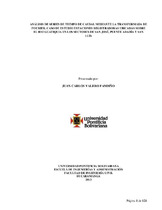| dc.contributor.advisor | Director. Guzmán Arias, Diego Alejandro | |
| dc.contributor.author | Valero Fandiño, Juan Carlos | |
| dc.coverage.temporal | 2013 | |
| dc.date.accessioned | 2020-03-12T15:10:39Z | |
| dc.date.available | 2020-03-12T15:10:39Z | |
| dc.date.issued | 2013-03 | |
| dc.identifier.uri | http://hdl.handle.net/20.500.11912/5075 | |
| dc.description | 121p.: (pdf); il; imágenes; gráficas y anexos. | spa |
| dc.description.abstract | El presente trabajo de grado tuvo como finalidad analizar tres series de caudal diarias suministrada por la Empresa de Acueducto y Alcantarillado de Bogotá (EAAB), provenientes de tres estaciones ubicadas a lo largo del rio Guatiquía en los sectores de San José, Puente Abadía y San Luis, con el fin de contribuir al conocimiento del comportamiento de los cauces colombianos. En el presente estudio se realizó un análisis exploratorio de los datos, encontrando numerosos vacíos de información, errores de digitación y valores repetidos de caudal; lo que conllevó a analizar fragmentos de cada una de las series de caudal. Una vez identificados los fragmentos se evaluó la memoria del proceso mediante dos técnicas: La función de autocorrelación lineal y el exponente de Hurst encontrando que los fragmentos de caudal exhibían una fuerte memoria. Finalmente para cada fragmento se identificaron sus armónicos importantes mediante la transformada directa de Fourier y se reconstruyeron los fragmentos mediante la transformada inversa de Fourier; lo anterior con el fin de identificar funciones matemáticas determinísticas de menor complejidad que encapsulasen el comportamiento general de las series de caudal original, para apoyar en un futuro procesos de modelación hidrológica de cauces y embalses, mediante la generación de series sintéticas de caudal. | spa |
| dc.description.abstract | The present grade work had as purpose to analyze three daily flow series river´s given by the water and sewage company of Bogotá (EAAB) coming from three stations located along the river Guatiquía in San José’s sectors, Puente Abadía and San Luis with the purpose of contributing to the knowledge of the behavior of the Colombian rivers. In this study an exploratory analysis of the data was made, finding numerous holes of information, typing errors and values repeated of flow; for this reason, were analyzed fragments of the original series. Once identified the fragments the memory of process was evaluated through two techniques: The autocorrelation function and the Hurst exponent, finding that the flow fragments showed a strong memory. Finally for each fragment identified it´s important harmonics through the direct Fourier transform and the fragments were reconstructed through the inverse Fourier Transform; the above mentioned with the purpose of identifying deterministic functions of smaller complexity that encapsulates the general behavior of the series of original flow, to support in a future processes of hydrological modeling of river and reservoirs, by means of the generation of synthetic series of flow. | eng |
| dc.format.mimetype | application/pdf | |
| dc.language.iso | spa | |
| dc.publisher | Universidad Pontificia Bolivariana | spa |
| dc.rights | Attribution-NonCommercial-NoDerivatives 4.0 International | * |
| dc.rights.uri | http://creativecommons.org/licenses/by-nc-nd/4.0/ | * |
| dc.subject | Empresas - Empresa de Acueducto y Alcantarillado de Bogotá (EAAB) | spa |
| dc.subject | Estaciones hidrométricas | spa |
| dc.subject | Cauce de los ríos | spa |
| dc.subject | Acueductos | spa |
| dc.title | Análisis de series de tiempo de caudal mediante la transformada de Fourier | spa |
| dc.type | Trabajo de grado | spa |
| dc.publisher.department | Escuela de Ingenierías | spa |
| dc.publisher.program | Ingeniería Civil | spa |
| dc.type.hasVersion | publishedVersion | spa |
| dc.description.sectional | Bucaramanga | spa |
| dc.description.degreename | Ingeniero civil | spa |


